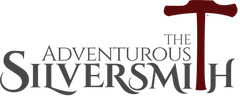One technique of metals I’ve wanted to explore is fold forming and months ago I purchased the definitive book on the subject – Foldforming by Charles Lewton-Brain http://www.amazon.com/exec/obidos/ASIN/1929565267/theganoksinpr-20
I figured this would be something I would eventually explore with Deb as there were so many other subjects and techniques to learn, it was quite a ways down on my list.
When I was down at the Vista Antique Gas & Steam Engine earlier in the month, I found out that they were having a 3 one day classes in fold forming and patina with each class being on a Sunday. I signed up for it immediately.
Two weeks ago was the first class and I had a great time. Pat Downing is teacher and he is a fun and very relaxed man – he spent the morning talking basics and demonstrating various folds. You can see some of his work here http://www.patdowning.com
In the afternoon we attacked the copper which he supplied as well as many hammers and other tools. Everyone in the class help each other with annealing the copper, ideas and great conversation.
(you can see pictures of my fold forming here)
I started off with just playing with some scrap so the first two aren’t really “anything”. I just made some practice folds with no ideas as to what or where to go with it. The third piece I made is a sample mini cuff, it might fit a small child but not an adult. I started off with the pulled fold and then saw it as a possible cuff design, so I worked it up with the material I had. After the mini cuff, I did a fold where the folded edge is forged to make longer and thus the piece will curve when opened. My next piece was a M fold (imagine the metal folded like the letter) a and this time I forged the bottom edge of the M which is the center fold and the legs on either side – just keep pondering this and when you see the picture, you will understand it.
This past Sunday I went to the second class were we learned how to do bowls and boxes and lids.
I only made 2 pieces but since one is a box with a lid, you could count it as three.
When I started the ‘cup’, Pat told me how he would do make it; then I told him how I wanted to do it and he could not see my idea. The conclusion, before I started, was hey, that was what experimentation is about. He went off to help another student and I set about to making my cup. When I was done I found Pat outside eating his lunch and showed it to him. He just shook his head in disbelief – because he really did not think it would work.
I then made my box. It is does not have a square footprint, it is actually more of a trapezoid with one of the short sides even shorter than its opposing side. I used a dapping punch on carpet to make the bumps on the box walls. Because of the trapezoid shape I had some difficulty cutting the bottom to fit inside and this resulted in me using a few more rivets to attach the bottom.
Pat had spent some time during the demo to tell us about making lids. He stated that placing a fold formed or flat piece of metal across the top of a box was not a lid if it was not fitted; nor was making a fitted lid that flat would not make the box interesting. Lids should add something to the box or bowl being made.
When I started the lid Pat commented on the folding, thinking I was making another piece like I did last week – no, I said as this was the start of lid. When I had the forging done and had opened the folds some I then flattened the legs, placed the piece on the box and told Pat I was done which resulted in a mild look of shock as he thought I was serious. At that point I relieved his fears and said I was just making a joke of what he had told us NOT to do, earlier.
I went and annealed the piece so I could then fold down the corners to make a fitted lid. This bending also pulled the fold formed section down and opened it a bit more. Once done I again showed Pat and he was pretty amazed at how I forged the M-fold and turned it into a lid; he also commented that maybe my background in raising has allowed me to see how to form the metal a little differently than him as he does not know how to raise.
After class, I offered to be his teaching assistant the next time he teaches the class. He is not teaching again until September and said that he would keep it in mind.
During this week, I will cleaning the pieces I made in class as well as a few other pieces including one or two from Haystack. Why?
Next Sunday is the third and final class with Pat. We will be doing patina, coating and sealants – some made from household items and some commercial patinas. We will be using some of our work from the prior 2 classes to apply the patina to. My husband Erich has decided to come to that class with me as the subject of patina and using household products to make them interests him. He is my chemical go to guy and he can mix up a mean pot of pickle!

 RSS Feed
RSS Feed
